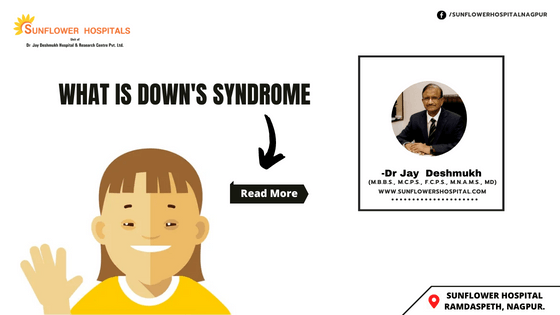What happens with this extra chromosome?
This extra chromosome also referred to as Trisomy 21 affects the baby’s brain and physical development and this is quite challenging to the baby and the family.
What are some common features of Down’s syndrome?
A flattened face, almond-shaped eyes, shorter, small hands and feet, short neck, small ears, a tongue that sticks out of the mouth, a single line across the palm of the hand. Physical growth delays, and mild to moderate intellectual disability are the most challenging features.
What are the other health problems associated with Down’s syndrome?
Hearing loss, obstructive sleep apnoea, ear infections, eye diseases, and heart defects are present at birth.
What are the causes and risk factors for Down’s syndrome?
The extra chromosome 21 leads to developmental and physical challenges. No one knows why Down’s syndrome occurs and what are factors responsible. One factor is the mother’s age. Women above the age of 35 years are likely to have a pregnancy affected by Down’s syndrome. However, this is not always true.
What is the treatment for Down’s syndrome?
One must find out the hidden talents of the affected individual. Each person. Chromosomes are small packages of genes in our bodies. They determine how our body forms and functions as it grows during pregnancy and after birth. Typically, a baby is born with 46 chromosomes. Babies with Down’s syndrome have an extra chromosome at number 21. The theme for World’s Down syndrome day, which comes in March, is that people with disabilities have the right to be treated fairly and have the same opportunities as everyone else.
Down syndrome has different talents and the ability to thrive. As this is a lifelong program, each child needs to have proper physical and occupational therapy. They may need extra help and attention at school. There are special schools for the mentally challenged, and every effort should be made to bring these children into the mainstream. This requires a lot of perseverance, discipline, and hard work. They need to be nurtured in a protected environment.
What is the incidence of Down’s syndrome?
This is one of the commonest chromosomal abnormalities in humans. It occurs in about 1 in 1000 babies. It is named after a British Doctor, John Langdon Down. The genetic cause of Down’s syndrome was discovered in 1959.
How is Down’s syndrome identified?
It is identified in pregnancy by prenatal screening, followed by diagnostic testing after birth. Since the introduction of screening, Down’s syndrome pregnancies are often aborted.
What are the screening tests done in the pregnancy in the first 3 and 6 months? Ultrasound examination of the baby in the uterus and blood tests for the mother that includes free and total Beta HCG and PAPP A. QUAD screen, integrated test, and cell-free fetal DNA are some other tests. If these tests come positive then after proper discussion an abortion may be planned. Ultrasound examination of the baby in the uterus is very helpful in predicting Down’s syndrome. Amniocentesis or chorionic villus sampling are more reliable tests but have some inherent risks.
What is the life expectancy for Down’s syndrome?
In the best possible circumstances, a life from 50 to 60 years is expected. A sheltered environment, proper Physiotherapy, and occupational therapy, admission to schools where children with learning disabilities are taken care of, and recognizing some intercurrent illnesses these individuals are prone to are important in their long-term survival.
Author: Dr Jay Deshmukh
Dr Jay Deshmukh is Chief Physician and Director, Sunflower Hospital, Nagpur Honorary Physician to Honorable Governor of Maharashtra and PondicherryCentral. Dr Jay Deshmukh is an M.B.B.S., M.C.P.S., F.C.P.S., M.N.A.M.S., MD From Internal Medicine – Bombay and New Delhi.


